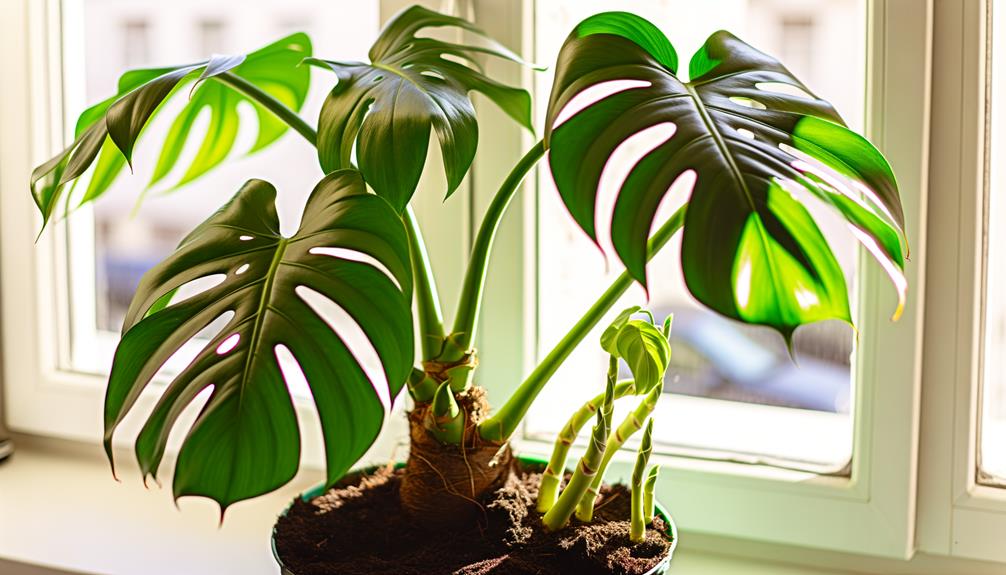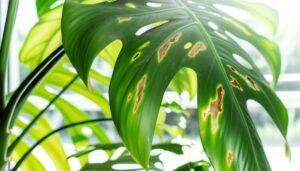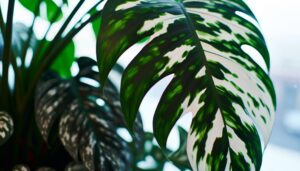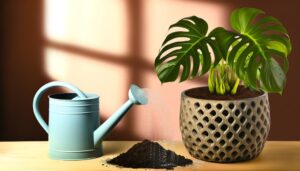Monstera Lechleriana Growth Rate
Monstera lechleriana grows moderately fast, reaching several feet in a single season under ideal circumstances. To maximize growth, make sure it receives bright, indirect sunlight and consistent watering.
Maintain high humidity and use well-draining soil to prevent root rot. A temperature range of 65-80°F (18-27°C) is best.
The plant thrives with aerial roots and robust stems, which help support its leaf mass. Periodic fertilization and pruning also promote healthy, vigorous growth.
Proper care tools and techniques, such as moss poles for climbing support, can greatly enhance its growth rate. Curious about optimizing your plant care even more?

Key Takeaways
- Monstera lechleriana is a moderately fast-growing plant.
- It can grow several feet in a single season under optimal conditions.
- Bright, indirect light is crucial for its vigorous growth.
- Consistent watering and high humidity levels promote faster development.
- Providing structural support helps maintain a healthy growth rate.
Natural Growth Patterns
Monstera lechleriana exhibits a natural growth pattern characterized by vigorous climbing and the development of large, fenestrated leaves. You'll notice it often grows towards light sources, using aerial roots to anchor itself to nearby structures.
This plant's leaves initially emerge as solid, but as they mature, they develop characteristic holes, or fenestrations, enhancing light capture and airflow. Its stems are robust, enabling it to support significant leaf mass without external aid.
You can expect the plant to consistently produce new growth, especially during warmer months. Understanding this pattern helps you anticipate its spatial needs and optimize its health. By recognizing these traits, you'll better appreciate the Monstera lechleriana's natural inclination for upward and outward expansion.
Influencing Factors
Several factors significantly influence the growth rate of Monstera lechleriana, including light intensity, humidity levels, soil composition, and temperature. By carefully managing these variables, you can maximize your plant's growth. For example, maintaining high humidity mimics the plant's natural rainforest habitat, promoting vigorous development. Similarly, choosing well-draining soil prevents root rot and ensures adequate nutrient absorption. Temperature also plays an essential role; Monstera lechleriana thrives in temperatures between 65-80°F (18-27°C).
Here's a quick reference table:
| Factor | Optimal Condition |
|---|---|
| Light Intensity | Bright, indirect light |
| Humidity Levels | 60-80% |
| Soil Composition | Well-draining, rich in organic matter |
| Temperature | 65-80°F (18-27°C) |
Light Requirements
Understanding Monstera Lechleriana's light requirements is important for best growth.
You should provide bright, indirect sunlight to mimic its natural habitat, though it can adapt to moderate indoor light conditions.
However, avoid low light situations as they can impede its growth and reduce foliage quality.
Optimal Sunlight Conditions
To secure best growth, it's crucial to provide Monstera Lechleriana with bright, indirect sunlight. This plant flourishes under conditions resembling its natural habitat—tropical rainforests where the canopy filters sunlight. Place it close to an east or north-facing window, making sure it receives sufficient light without direct sun exposure, which can damage its leaves.
Direct sunlight for extended periods can cause leaf burn, decreasing photosynthetic efficiency. Aim for about 10,000 to 20,000 lux; this guarantees the plant has enough light for prime growth without excessive stress. If natural light is inadequate, consider using full-spectrum grow lights to supplement.
Consistent lighting conditions help sustain vigorous growth and vibrant foliage, ensuring your Monstera Lechleriana remains healthy and flourishing.
Indoor Light Adaptability
Monstera Lechleriana easily adjusts to various indoor light conditions, although it thrives best in bright, indirect light. You'll find it growing more robustly in rooms with filtered sunlight. Direct sunlight might scorch its leaves, so it's essential to place it away from harsh rays. Artificial light can also support its growth, but natural light remains ideal.
| Light Condition | Effect on Growth |
|---|---|
| Bright, indirect light | Ideal growth, large leaves |
| Low light | Slower growth, smaller leaves |
| Direct sunlight | Leaf scorch, potential damage |
| Artificial light | Moderate growth, acceptable |
| Filtered sunlight | Healthy growth, vibrant foliage |
Shade Tolerance Levels
While bright, indirect light suits Monstera Lechleriana best, it also demonstrates remarkable shade tolerance, allowing it to adapt well to lower-light environments. This adaptability stems from its natural habitat, where it often grows under dense forest canopies. When placed in lower light conditions, you'll notice a slower growth rate, but the plant will still thrive.
It's essential to avoid complete darkness, as the plant needs some light for photosynthesis. If light levels are too low, leaf size may reduce, and internodes may elongate. Maintain at least moderate light to support healthy foliage. You can use grow lights to supplement natural light if needed.
Regularly monitor the plant's health to adjust lighting conditions accordingly for optimal growth.
Watering Needs
Proper watering is vital for Monstera Lechleriana, as it requires consistently moist but well-draining soil to thrive. You should water it thoroughly, allowing excess water to drain out to prevent root rot. Monitoring the moisture level of the soil is essential; aim to keep it damp but not soggy.
Here are some key points to keep in mind:
- Water frequency: Water when the top inch of soil feels dry.
- Water quality: Use filtered or rainwater to avoid chlorine and fluoride buildup.
- Humidity: Maintain higher humidity levels around the plant.
- Drainage: Ensure the pot has drainage holes to avoid water stagnation.
Soil and Fertilization
Selecting the right soil mix is crucial for Monstera Lechleriana's health, as it requires a well-aerated, nutrient-rich medium to support its robust growth. Aim for a mix containing peat moss, perlite, and pine bark to guarantee ideal drainage and aeration. This combination mimics the plant's natural habitat, promoting healthy root development.
For fertilization, apply a balanced, water-soluble fertilizer with an N-P-K ratio of 20-20-20 every four to six weeks during the growing season. Avoid over-fertilizing, as it can lead to nutrient burn. Dilute the fertilizer to half the recommended strength to prevent root damage.
Consistent monitoring of soil pH, ideally between 5.5 and 7, ensures nutrient availability and absorption.
Pruning and Support
To achieve peak growth of your Monstera Lechleriana, you should follow specific pruning best practices and provide adequate support for its climbing nature.
Use sharp, sterilized tools to trim excess foliage and encourage healthy development.
Additionally, consider utilizing moss poles or trellises to support vertical growth and prevent damage.
Pruning Best Practices
When pruning Monstera lechleriana, utilize sterilized tools to prevent the spread of pathogens and support the plant's health. Carefully target the right areas to maintain its shape and encourage healthy growth. Focus on removing dead or yellowing leaves first, as this promotes better light penetration and air circulation.
Remember these pruning best practices:
- Cut just above a node: This guarantees new growth will emerge.
- Angle your cuts: An angled cut reduces water accumulation, minimizing rot risk.
- Avoid over-pruning: Excessive trimming can stress the plant, leading to slower growth.
- Prune during the growing season: Pruning in spring or summer maximizes recovery and growth.
Supporting Climbing Growth
Securing Monstera lechleriana thrives as a climbing plant involves providing adequate structural support and strategic pruning. You'll need to install a robust moss pole or trellis to mimic its natural habitat, allowing the aerial roots to anchor and climb.
Regular pruning is essential to control growth and encourage the plant to develop a bushier, more robust form. Trim any leggy or excessively long vines to redirect the plant's energy toward healthier, more vigorous growth. Strategic pruning also promotes better sunlight penetration and air circulation, reducing the risk of fungal infections.
Always use clean, sharp tools to make precise cuts just above a node. This care will guarantee your Monstera lechleriana remains healthy and visually appealing.
Tools and Techniques
Mastering the essential tools and techniques for pruning and supporting your Monstera lechleriana promotes ideal growth and plant health. Begin by selecting the right tools to secure clean cuts, which prevent disease and encourage vigorous growth.
- Sharp pruning shears: Use these for precise cuts on stems and leaves.
- Sterilizing solution: Clean your tools before and after use to secure pathogen spread.
- Moss poles or trellises: Provide structural support to guide vertical growth.
- Twist ties or plant clips: Secure stems to supports without damaging the plant.
Prune regularly to remove dead or yellowing leaves, and trim leggy growth to maintain a compact, bushy appearance. Supporting climbing growth with moss poles or trellises encourages aerial root development and healthier foliage.
Conclusion
In nurturing your Monstera lechleriana, think of it as guiding a river to its full, flowing potential. Light, water, and soil are your tools to carve its path.
Pruning and support act as the riverbanks, directing its growth with precision. By understanding its natural patterns and needs, you're not just growing a plant—you're crafting a living masterpiece, a tribute to the delicate balance of nature and your attentive care.






